Inside\Within is a constantly updating web archive devoted to physically exploring the creative spaces of Chicago's emerging and established artists.
Support for this project was provided by The Propeller Fund, a joint administrated grant from Threewalls and Gallery 400 at The University of Illinois at Chicago.

Search using the field below:
Or display posts from these tags:
3D printing 3D scanning 65 Grand 7/3 Split 8550 Ohio 96 ACRES A+D Gallery ACRE animation Art Institute of Chicago Arts Incubator Arts of Life audio blogging Brain Frame CAKE Carrie Secrist Gallery casting ceramics Chicago Artist Writers Chicago Artists Coalition Chicago Cultural Center Cleve Carney Art Gallery Clutch Gallery Cobalt Studio Coco River Fudge Street collage collection Columbia College Chicago Comfort Station comics conceptual art Contemporary Art Daily Corbett vs. Dempsey Creative Capital DCASE DePaul University design Devening Projects digital art Dock 6 Document drawing Duke University dye Elmhurst Art Museum EXPO Chicago Faber&Faber fashion fiber Field Museum film found objects GIF Graham Foundation graphic design Harold Washington College Hatch Hyde Park Art Center illustration Image File Press Imagists Important Projects ink installation International Museum of Surgical Science Iran Jane-Addams Hull House Museum jewelry Joan Flasch Artist's Book Collection Johalla Projects Julius Caesar Kavi Gupta Links Hall Lloyd Dobler LVL3 Mana Contemporary metalwork Millennium Park Minneapolis College of Art and Design Monique Meloche Museum of Contemporary Art Chicago (MCA) Museum of Contemporary Art Detroit (MOCAD) Museum of Contemporary Photography (MoCP) National Museum of Mexican Art (NMMA) National Resources Defense Council New Capital Northeastern Illinois University Northwestern University Ox-Bow painting paper mache Peanut Gallery peformance Peregrine Program performance photography PLHK poetry portraiture printmaking public art Public Collectors publications Renaissance Society risograph rituals Roman Susan Roots&Culture SAIC screen printing sculpture Sector 2337 Shane Campbell Silver Galleon Press Skowhegan Slow Smart Museum Soberscove Press social practice South of the Tracks Storefront SUB-MISSION Tan n' Loose Temporary Services Terrain Terrain Biennial text-based textile textiles The Banff Centre The Bindery Projects The Cultural Center The Franklin The Hills The Luminary The Packing Plant The Poetry Foundation The Poor Farm The School of the Art Institute of Chicago (SAIC) Threewalls Tracers Trinity College Trubble Club University of Chicago University of Illinois at Chicago (UIC) University of South Florida at Tampa Valerie Carberry Vermont Studio Center video weaving Western Exhibitions wood carving woodwork Yellow Book Yollocalli Arts Reach zinesInside\Within is produced in Chicago, IL.
Get in touch:
contactinsidewithin@gmail.com
Kirsten Leenaars's Operatic Coordinations
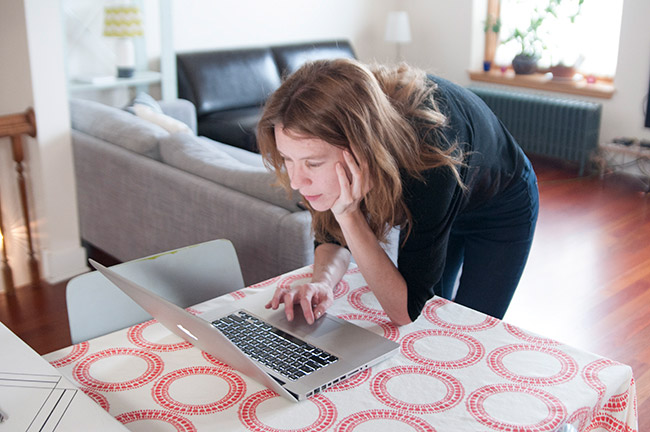
Kirsten is a Dutch artist whose minimal and open studio is found within her home on the north end of Humboldt Park. Crafting childlike sets, Kirsten creates spaces where her participants often play themselves in collaborative narratives.
I\W: How did you develop the soap opera you worked on for the MCA, “On Our Way to Tomorrow?”
KL: Eighty percent of the actors were staff members of the museum. The curator played the curator and the administrative assistant played the administrative assistant. I based it on a month-long research period at the museum. I was at every meeting, interviewed everyone, and met all the board members. I wanted it to be based on real things that happened, but have everyone play a fictionalized version of themselves. Everyone knew that they were going to play whatever function they were at the museum at that time, but they could tell me that they wanted to be ambitious or another characteristic, and based on that I developed story lines for them specifically.
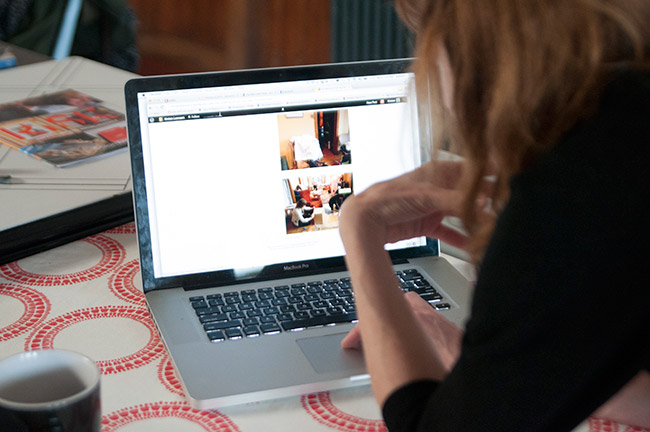
Did you know from the beginning of the project that you wanted to create a soap opera?
At first I was asked to do a performance project at the museum, but I don’t really do performance and there was a requirement that the audience should be able to interact. That is something that I don’t really do either, so I thought how can I come up with something that is closer to what I do, but also fits the criteria. It also had to take place during opening hours, and be visible to the visitors. It was shot all on the exhibition site, so the other art works became a set for my soap opera. There was one little recycled house which was Dan Peterman‘s and it was meant to be interacted with. That became the function for all sorts of meeting places. In the end I shot for two weeks. We worked from eleven until closing time so the audience could see what was happening. There were constantly people walking in and out of the frame. I have never done anything like that, and I had no idea how I was going to pull it off. I edited 13 twelve and a half minute episodes, so it was structured like a season. In the end maybe 32 people participated, so there were 32 story lines I had to weave together. The longest video I had made up until then was 10 minutes.
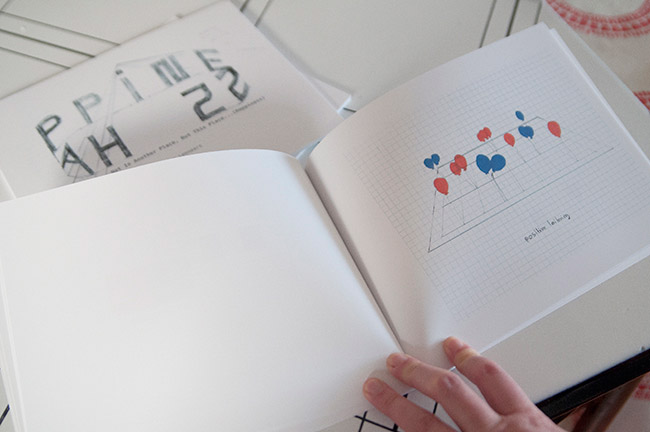
What was your idea behind the removed role of the self in both “On Our Way to Tomorrow” and “Not In Another Place, But This Place…(Happiness)?”
I am interested in how we represent ourselves, how the camera mediates that. When do we perform, and when we are authentic? I am usually surprised that people kind of do what I ask them to do, but I think that is partially because people like that moment of play. They also like the chance to do something they don’t usually do. I used to do a lot of photography, and I thought about what portraiture is and if you can capture someone’s essence. In some ways I used to be a neutral observer, but I also am never a neutral observer because I am always framing. However, when I moved to stage portraits, and asked my subjects how they wanted to be staged, it seemed like a more accurate reflection of someone than me just snapping pictures. I then realized through that exchange that I loved the model of collective making. It is not just me making the decisions, I set up a framework that is the playground for whomever is participating to do whatever they want.
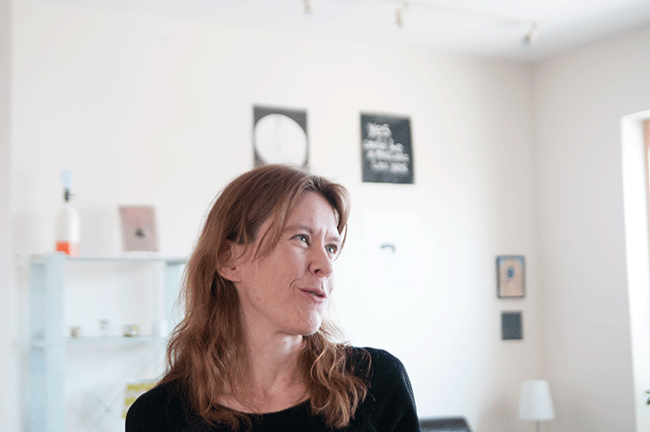
How did you make the transition from still to moving image portraiture?
I think going to UIC instigated that. I had access to cameras. With photography I always felt a little frustrated with just the one image. Specifically because I was maybe more obsessed with the story behind a picture rather than the picture itself. Video I saw as a space to put in much more narrative and work with movement. I love movement and sound and have a sculpture background, so I was excited to make sets and props. It just made sense.
What qualities to you have in common with a director?
I guess more and more I am shifting to a director role, but I never work with a script or a storyboard. I work now with two cameramen that have worked with me for the last three video projects. It has been really amazing and they know intuitively what I want. I leave it up to them, they have much more knowledge than I do—I trust them completely. Sometimes I will give them some direction. I usually call the actors ‘participants,’ but they are always real people. It is more like I am giving them instructions. I never tell them exactly what to do. I accept whatever they come up with. I guess I like that surprise, or I am curious how someone will interpret what I give them and what they will come up with. It is always very different from what I had imagined.
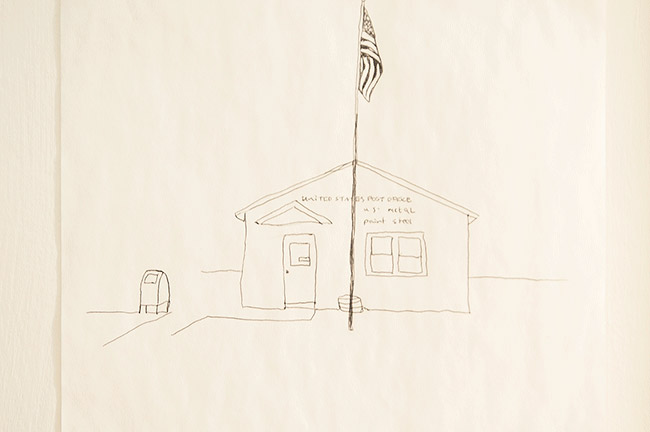
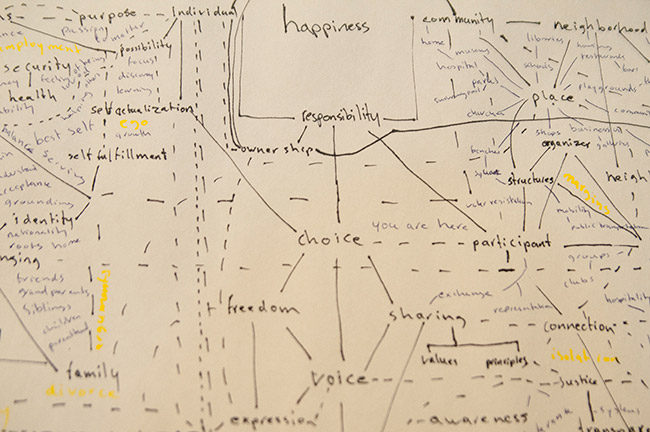
Does this complete acceptance tie into your viewpoint of love?
Yeah! Whenever I say ‘love’ people get nervous, but for me love is this place of acceptance. It is not romantic love, it is a general love. Thinking about how you approach people with love—without sounding like a hippie. For me that is accepting the other. There was a German choreographer Pina Bausch who I really connected with the way she worked. She found a richness in having no preconceived notions of what something needed to look like, just seeing what happened.
The sets you build have a real craft aspect to them. Is that a nod to democratizing the art making?
Yes, but I just also really love cardboard. I love making things from everyday materials. It is an appeal to your imagination—what can you see in these everyday materials. I think partially it has just been a financial necessity. I like making do with what is there, and seeing what I can use. I think another aspect of it was celebrating Sinterklaas growing up. There is this tradition of making gifts for your loved ones where you make it a gift within a gift. They are always made with cardboard paper and cardboard rolls—you work with whatever materials are in your home. I think part of my aesthetic or craftiness also comes from that. Those were my first narrative objects.


